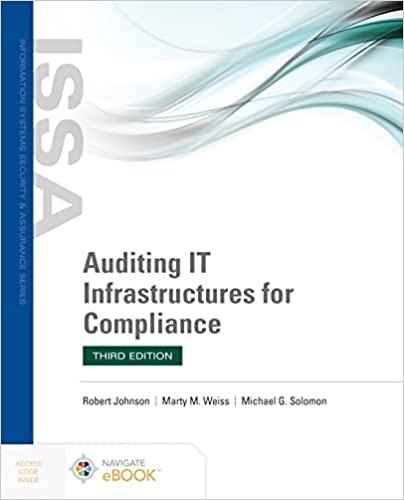Question
Assessment Brief/ Task The detailed requirements for this task are as follows: Enron Corporation (former NYSE ticker symbol ENE) was an American energy, commodities, and
Assessment Brief/ Task The detailed requirements for this task are as follows: Enron Corporation (former NYSE ticker symbol ENE) was an American energy, commodities, and services company based in Houston, Texas. Before its bankruptcy on December 2, 2001, Enron employed approximately 20,000 staff and was one of the world's major electricity, natural gas, communications, and pulp and paper companies, with claimed revenues of nearly $101 billion during 2000. Fortune named Enron "America's Most Innovative Company" for six consecutive years. At the end of 2001, it was revealed that its reported financial condition was sustained substantially by an institutionalized, systematic, and creatively planned accounting fraud, known since as the Enron scandal. Enron has since become a well-known example of willful corporate fraud and corruption. The scandal also brought into questions the accounting practices and activities of many corporations in the United States and was a factor in the creation of the SarbanesOxley Act of 2002. The scandal also affected the greater business world by causing the dissolution of the Arthur Andersen (AA) accounting company. Enron filed for bankruptcy protection in the Southern District of New York during late 2001 and selected Weil, Gotshal & Manges as its bankruptcy counsel. It ended its bankruptcy during November 2004, pursuant to a court-approved plan of reorganization, after one of the most complex bankruptcy cases in U.S. history. A new board of directors changed the name of Enron to Enron Creditors Recovery Corp., and emphasized reorganizing and liquidating certain operations and assets of the pre-bankruptcy Enron. On September 7, 2006, Enron sold Prisma Energy International Inc., its last remaining business, to Ashmore Energy International Ltd. (now AEI). Tasks:
1. Discuss the corporate governance failure leading to the collapse of Enron.
2. Discuss the role of audit firm AA and failure of the accounting profession leading to the collapse of Enron.
3. Discuss whether a coded law (i.e. an Act) can mitigate the problem of accounting and corporate scandals given the US example of SOX.
4. Compare and contrast voluntary based and coded-law approach to corporate governance.
Recommended Reading This is an indicative list of journal articles on agency theory and corporate governance. Adams, R.B., Hermalin, B.E. & Weisbach, M.S. (2010). The Role of Boards of Directors in Corporate Governance: A Conceptual Framework and Survey, Journal of Economic Literature, 48(1), 58-107, Aguilera, R., & Cuervo-Cazurra, A. (2009) Codes of good governance, Corporate Governance: An International Review, 17(3), 376-387 Carver, J. (2010) The case for global governance theory: practioners avoid it, academics narrow it, the world needs it, Corporate Governance: An International Review, 18(2), 149-157 Daily, C.M., Dalton, D.R. and Cannella, Jr, A.A., (2003) Corporate governance: decades of dialogue and data, Academy of Management Review, 28 (3), 371-382 Dalton, D.R., Daily, C.M., Ellstrand, A.E., and Johnson, J.L. (1998) Meta-analytic review of board composition, leadership structure, and financial performance, Strategic Management Journal, 19, 269-280 Dalton, D.R., Daily, C.M., Certo, S.T., and Roengpitya, R., (2003) Meta-analyses of financial performance and equity: fusion or confusion? Academy of Management Journal, 46 (1), 13-26 Dalton, C.M. and Dalton, D.R., (2005) Boards of directors: utilizing empirical evidence in developing practical prescriptions, British Journal of Management, 16, S91-97 Durisin, B. & Puzone, F. (2009) Maturation of corporate governance research, 1993-2007: An assessment, Corporate Governance: An International Review, 17(3), 266-291 Garcia-Castro, R., Aguilera, R.V. & Arino, M.A. (2013) Bundles of corporate governance practices: A fuzzy set analysis, Corporate Governance: An International Review, 21(4), 390-407 Hermalin, B.E. and Weisbach, M.S. (2003) Boards of directors as an endogenously determined institution: a survey of the economic literature, Economic Policy Review, 9 (1), 7-26 Jensen, M.C., and Meckling, W.H., (1976) Theory of the Firm: Managerial behaviour, agency costs and ownership structure, Journal of Financial Economics, 3, 305-360 Yoshikawa, T. & Rasheed, A.A. (2009) Convergence of corporate governance: Critical review and future directions, Corporate Governance: An International Review, 17(3), 388-404 Zattoni, A., & Cuomo, F. (2008) Why adopt codes of good governance? A comparison of institutional and efficiency perspectives, 16(1), 1-15 Zattoni, A. & Van Ees, H. (2012) How to contribute to the development of a global understanding of corporate governance? Reflections from submitted and published articles in CGIR, Corporate Governance: An International Review, 20(1), 106-118 The Committee on the Financial Aspects of Corporate Governance, Chaired by Sir Andrian Cadbury (1992). Directors Remuneration Report of study group chaired by Sir Richard Greenbury (1995). The Combined Code Principles of Good Governance and Code of Best Practice Chaired by Sir Ronald Hampel (1998)
Step by Step Solution
There are 3 Steps involved in it
Step: 1

Get Instant Access to Expert-Tailored Solutions
See step-by-step solutions with expert insights and AI powered tools for academic success
Step: 2

Step: 3

Ace Your Homework with AI
Get the answers you need in no time with our AI-driven, step-by-step assistance
Get Started


